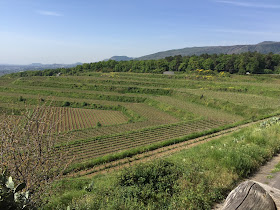While a lot of attention, as regards Piemontese winemaking, has revolved around the battle of the modernists versus traditionalists, or the Burgundization of Barolo, the region has also been undergoing an under-reported transformation: the rise of women into the wineries' leadership ranks. And it is this under-explored story that Suzanne Hoffmann captures, and tells effectively and empathetically, in her initial publication Labor of Love: Wine Family Women of Piemonte.
Out in the hills of the Langa, Asti, and nearby regions, society is rooted in tradition. There are a lot of good reasons for this as these areas were fairly poor farming communities until just the last 30 - 40 years. The family unit was and is still valued and respected above most all else. Piemonte has a tumultuous political history as well and the family unit had to be maintained to develop a sense of identity when the outside world was in flux.Suzanne, in her introductory chapter of the book, builds on the foregoing and shows its implication on the Piemontese landscape: "Though women were the glue that held so many families together through war, poverty, and political upheavals, there had existed a societal prohibition against their inheriting land and working it as wine producers."
But, according to Suzanne, as she became more familiar with the region (and its people), she noted that a seismic change in this system was underway, led 9in the 1980s) by a number of "strong, courageous women ... who took the helm of their wineries." And this trend will most likely be further solidified by the fact that a number of young women began studying winemaking at the Enological School in Alba in the 1990s and are working alongside their fathers and grandfathers today, poised to take over ownership reins when/if the occasions presents themselves.
It is these stories that Suzanne explores in the Labor of Love. A total of 22 wine families (shown in the chart below) with women in leadership positions are profiled therein. But this is not a cookie-cutter book.
The book begins with an introductory chapter which relays the story of Suzanne's introduction to the region and a fortuitous meeting with Jeffrey Chilcott, the Marchesi de Gresy Cellar Master (I have had difficulty finding that estate in the middle of the day) which opened the door to this entire venture. Beyond that introductory chapter, each estate is treated in a separate chapter.
Each chapter begins with a genealogical chart but that is where the similarity ends as the stories are all so different. If we examine the first five stories that bear on the subject at hand, four of the estates are currently women-owned while the fifth features a woman who works alongside her father in the cellar while her sister works in Germany distributing the estate's wines. Of the four owners, three own the estates outright while the fourth is owned by three sisters. Of the three that are solely owned, one was acquired through an inheritance, the second was an acquisition, while the third took ownership upon the sudden death of her husband.
There are a wealth of stories here and Suzanne captures the threads and weaves a rich tapestry which takes us behind the labels and into the inner workings of a female-led enterprise. We see the challenges they face, challenges which would be foreign to their male counterparts -- in some cases challenges created by their male counterparts --and the solutions that they bring to bear on the problem. We see young women working alongside their mothers and wrestling with the issue as to whether they should follow their parent into this industry. We see the conflicted mothers, staying above the fray as children wrestle with that decisionmaking process.
Suzanne has a deep passion for the region and its people. And it shows. In the events preceding the book launch I saw her easy familiarity with, and deep knowledge of, the family running the Il Centro Restaurant in Priocca. I saw the joy in that family's eyes when Suzanne formally presented them with a copy of the book and told them the inspirational role they played in the project.
I saw it in the attendees at the launch event. The venue was packed, with almost total representation of the families included in the book. I saw their pride in the fact that their stories had been recognized, documented, and was being told to the outside world. And with the reputation that the region has for being insular, it was a testament to Suzanne's earnestness, tenacity, and reassuring persona, that they entrusted her, an outsider, with the material to tell the stories.
This is a beautifully presented book. Stunning front and back covers, high quality paper, and a multitude of high-grade photographs, many of the latter provided by the wine families themselves. This is a book befitting the subject and the region. And your bookshelf.
©Wine -- Mise en abyme
































